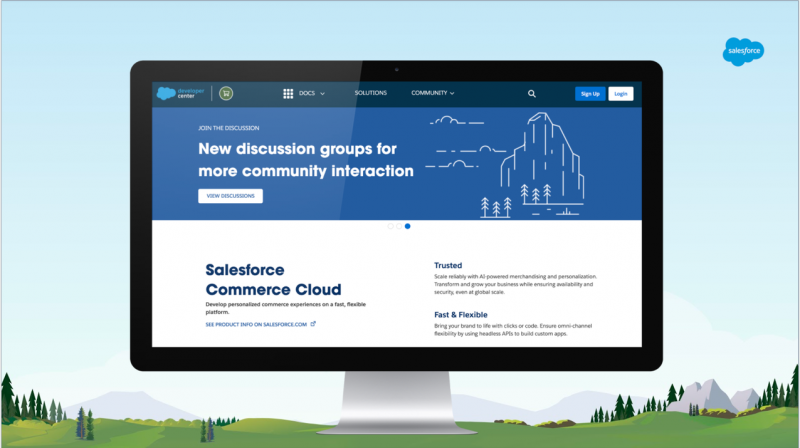Commerce has become an integral part of the post-coronavirus recovery of every business. Whether it be branded manufacturers going direct-to-consumer for the first time using Quick Start Commerce Solutions, or companies changing their operating models to create revenue with curbside and delivery apps.
Developers are a critical part of every company’s innovation strategy, and critical to commerce transformation. They deliver new functionality and experiences that engage shoppers and stay ahead of consumer expectations. With the coronavirus crisis accelerating the pace of change in business, IT teams need to embrace innovation at a never-before-seen pace.
Enhancing developer productivity is why Commerce Cloud built the Commerce Cloud Developer Center, a new public developer portal for all developers building commerce applications. The Commerce Cloud Developer Center is the primary source of information and guidance for developing on the Salesforce commerce platform. Developers can access all of the resources and best practices —including documentation and APIs— and also participate in a thriving developer community.

To help introduce the Commerce Cloud Developer Center to Salesforce developers, we’ve tracked down Salesforce Trailblazer, Gaurav Kheterpal for a Q&A. Gaurav is the Chief Technology Officer at MTX Group. A developer at heart and a technical architect by role, Gaurav is a five-time Salesforce MVP and a certified technical instructor, with 34 Salesforce & Mulesoft Certifications.

Gaurav, you are most known for your Salesforce developer expertise, but you have a background in commerce. Can you share?
My first introduction to commerce was way back, when it was in a nascent stage. I did some projects on a few niche ecommerce platforms, but I quickly moved to Demandware starting in 2015, and with the Salesforce acquisition, we founded a commerce practice at my company. I’ve built a number of Commerce Cloud storefronts and AppExchange cartridges, but most of all, love teaching developers about how to build on the Salesforce commerce platform.
How has commerce development changed in the new COVID-19 world?
The global pandemic has made a huge change to the world of commerce in general. While most other sectors have struggled in this new normal, ecommerce has picked up big time with many countries in the world being forced to lock down. The focus has moved from in-store sales to ecommerce and I believe this trend is here to stay at least for a couple of years.
In terms of specific changes, the commerce world has quickly brought on the required innovation to support contactless payments, delivery, curbside pickup, and new digital campaigns — all of which developers play a critical role in.
How has Commerce Cloud opened its doors to Salesforce developers?
It has been fantastic to see Commerce Cloud evolve to a full platform at Salesforce. Before it was a closed ecosystem, which didn’t jive with the Salesforce developer. But since, the Commerce Cloud team has made all the right moves to increase adoption and developer penetration. The Trailblazer Community and the new Commerce Cloud Developer Center are great examples of this.
Headless commerce is a hot-topic for developers today, but is one of the most misunderstood terms in the industry. What is your take?
Headless commerce is the process on how to build commerce apps, and it is still in a growth stage. The industry is in a phase of migrating into a more headless paradigm, where 2020 may be the year it really takes off. What’s important to understand is headless is not a product, it is a platform, with solutions that are scalable and extensible. Right now I am seeing a number of headless projects evolve and I’ve seen Commerce Cloud taking a step ahead with their new APIs. It is a futuristic platform where you can scale up for the next 10 years, and do headless in conjunction with a modern storefront.
What do developers need to do to stay agile and build headless commerce applications?
Building headless means taking an API driven approach. It really starts with the fundamentals, knowing what APIs you need, how to write APIs, and how to consume APIs. The Commerce Cloud APIs have taken a massive jump in evolution. Developers are able to use Swagger and Open API tools to point the front-end exactly where it needs to go on the back. It’s a lot more coherent, and developers have full visibility into all calls.
Once you get going, in order to achieve rapid application development, developers need a platform. With the Salesforce platform, we talk about it from a no-code, low-code, and code perspective. The Salesforce commerce platform has this, with Page Designer’s drag-and-drop components and builder capabilities.
How have you been using the new Commerce Cloud Developer Center?
I love it. The Commerce Cloud Developer Center fills a large void, as before there was a lack of coherence for Salesforce developers, Commerce Cloud had its own experience. The Developer center brings together a developer forum, the Trailblazer Community, and Trailhead. I like the way the API documentation is put together, and the API mocking service is cool. Not only will developers build commerce projects faster, all of the information will help a lot of people working towards their Commerce Cloud developer and architect certifications.
Conclusion
We invite you to explore, ask questions, and bookmark developer.commercecloud.com for future reference. Be sure to take advantage of the Salesforce headless commerce modules on Trailhead:
Headless Commerce Basics
Headless Implementation Strategies
Headless Developer Tools
About the author
Eric Lessard is a Product Marketing Manager for Salesforce Commerce Cloud, focused on digital innovation and empowering developers. Eric has over a decade of experience in high-tech marketing serving in field, go-to-market, and product roles in both EMEA and US. Eric holds a BS from Fairfield University and MBA from Babson College.